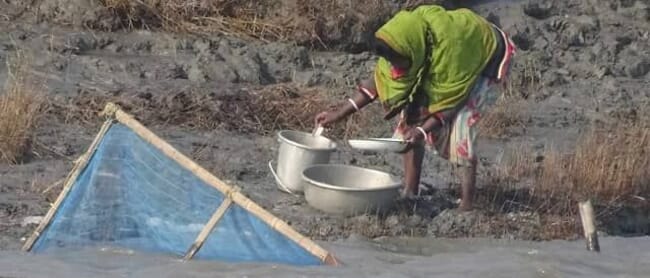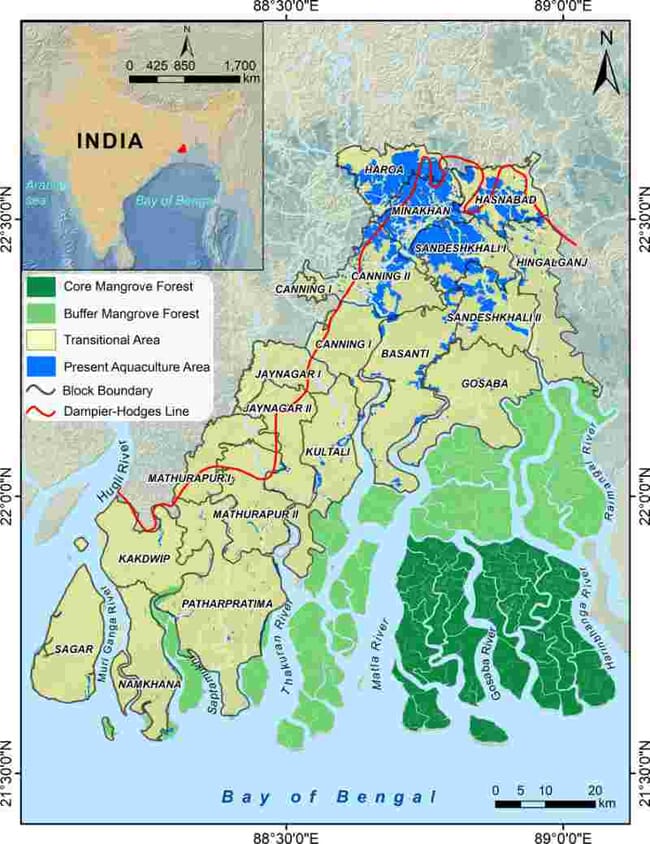
Profits from a boom in brackish-water aquaculture are primarily going to groups of external investors and do not significantly improve the wellbeing of the local community around Sundarbans, a biosphere reserve in eastern India, according to the authors © S Giri
Around Sundarbans, a biosphere reserve in eastern India, more and more farmland is converted into brackish-water aquaculture – despite its risk for detrimental effects on environment and local livelihoods.
“The emergence and rapid expansion of brackish-water aquaculture in Sundarbans threatens to cause long-term consequences such as loss of biodiversity and socioeconomic impacts,” said Tim Daw, a researcher at Stockholm Resilience Centre, who is one of the authors behind a study recently published in Ambio.
What drives this land change has earlier been disputed. The Ambio study points to economic profitability as the main reason for the conversion.
But even environmental reasons play a role as agricultural productivity has dropped due to salinisation, frequent cyclones, flooding and a diminishing availability of freshwater for irrigation.
At the core of the study are interviews with 67 aquaculture farmers in the region.
“Profits are primarily going to groups of external investors and do not significantly improve the wellbeing of the local community,” said Max Troell, another centre researcher and author on the study.

In the core area no human activities are allowed except research with the prior permission of the forest department. In the buffer zone, fishing and honey collection are allowed with permits from the forest department. All kinds of human activities are allowed in the transition zone only. Dampier-Hodges line which is indicated here is an imaginary line drawn in 1829–1830 to mark the northern boundary of saline influence in the Sundarbans delta. © Daw et al
Bycatch and biodiversity loss
According to the researchers, the shrimp are exported and large part of the financial profits are accumulated outside the communities. Furthermore, shrinking farmland available for the production of staple food crops, local food security is jeopardised.
Moreover, they are concerned about the detrimental effects on the environment, noting that it can cause soil salinisation and degrade land that then cannot be turned back into farmland. Furthermore, more intensive aquaculture systems require chemicals such as fertilisers which can leach and harm local ecosystems.
Even traditional systems rely largely on the collection of wild-caught juvenile shrimps which are then kept in ponds until they are fully grown. This results in a lot of bycatch and risks depleting the region’s biodiversity, they argue.
A way forward?
Since neither traditional nor modern intensive systems of aquaculture bring sustainability to the region, the authors suggest a middle-way which can provide more income to farmers but does not come with the adverse effects of intensive cultivation.
In these improved-traditional systems, which are already practiced by some farmers that participated in the study, seasonal ponds are stocked with bought prawn seeds which are not wild-caught.
Additionally, the researchers give the following suggestions for supporting sustainability in the region:
- Strictly enforce laws that prohibit further illegal conversion of farmland to aquaculture.
- Create alternative livelihoods for those people, many of them women, who are currently depending on collecting wild juvenile shrimp.
- Strengthen current agriculture with rainwater harvesting.
- Promote conservation and expansion of mangrove forests.



